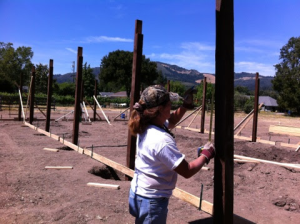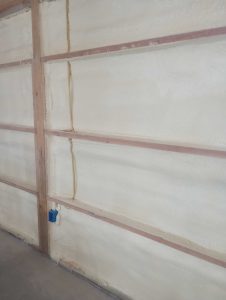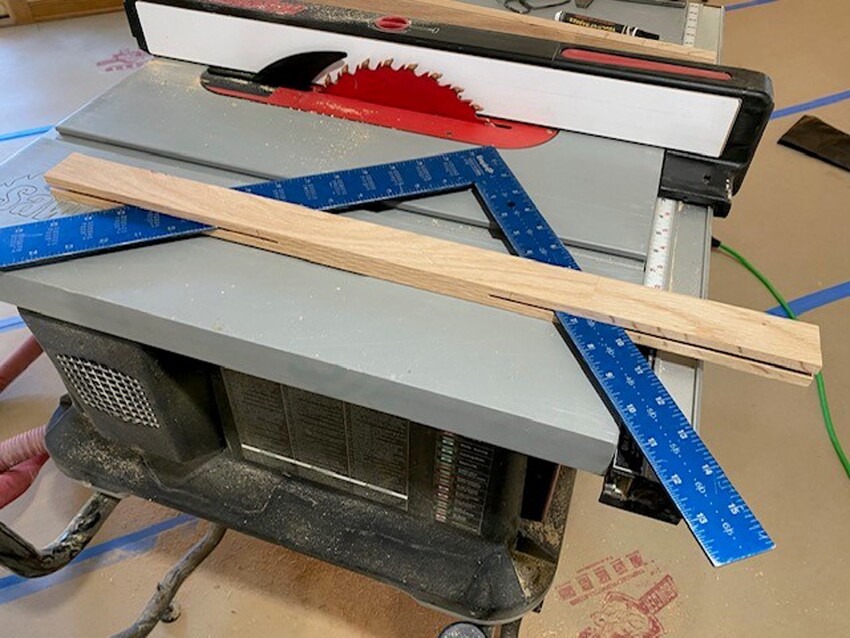Hopefully you’ve been riding along with me here on my frost heave “horse” over the past two days, with background information provided by Harris Hyman, P.E. If not, you can quickly click on the past two day’s blogs, and catch up. Or…. skip ahead here if you want the “down and dirty” on what to do about frost heaves.
 A solution to frost heaves in pole building construction is relatively simple and is supported by the building codes. When digging the holes for the building columns, make sure the bottom of the hole is below the frost line. Widen out the bottom of the hole, so it is several inches larger in diameter than the upper portion of the hole. Backfill the bottom of the hole, including the column base with premix concrete. The weight and size of the concrete plus the weight of the earth above the footing will hold the post down.
A solution to frost heaves in pole building construction is relatively simple and is supported by the building codes. When digging the holes for the building columns, make sure the bottom of the hole is below the frost line. Widen out the bottom of the hole, so it is several inches larger in diameter than the upper portion of the hole. Backfill the bottom of the hole, including the column base with premix concrete. The weight and size of the concrete plus the weight of the earth above the footing will hold the post down.
Good building site preparation can minimize or eliminate potential frost heaves beneath concrete slabs. Remove all sod and vegetation, as well as topsoil (which can be stockpiled for later use in finish grading). Remove any clay or silty soil from within the future building “footprint”. Replace subsoil removed from around building with granulated fill to help drain subsurface water from building.
Distribute all fill, large debris free (no pit run), uniformly around site in layers no deeper than six inches. To maintain frost-free soils sub-base should be such that no more than 5% (by weight) will pass the No. 200 sieve, and it is further desired no more than 2% be finer than .02 mm.Compact each layer to a minimum 90% of a Modified Proctor Density before next layer is added. Usually, adequate compaction takes more than driving over fill with a dump truck, or earth moving equipment. A large vibratory compactor, or road roller (aka “steam roller) is best used to achieve a proper degree of compaction.
Prior to pouring concrete, spread 2” to 6” of clean and drained sand or sandy gravel below where concrete is to be poured. Mechanically compact the fill, so as not to cause the slab to sink. Install a good well-sealed vapor barrier (such as 15mil black plastic) below any interior pour, to stop moisture from traveling up into slab through capillary action. If not using fiber-mesh or similar reinforcement additives to concrete mixture, place wire mesh or rebar (reinforcing steel or fiberglass rods) in slab center to add rigidity to concrete to aid in minimizing cracking.
And there you go! As the saying goes, “an ounce of prevention is worth a pound of cure.” We’ve followed these practices over the past over 33 years of 14,000 plus buildings, and I’ve yet to have anyone report their building “heaving” due to frost. If you don’t work to prevent it, I can guarantee the “cure” will not be pretty! Have a good weekend all – see you back Monday with “Why not stick-built construction”?










You wrote: “Remove any clay or silty soil from within the future building “footprint”.”
This is not always possible. Where I live, for instance, the ground consists of about 6″ of topsoil followed by many feet of clay which goes to bedrock. You cannot remove this clay. You also do not want to dig any of the clay out because unless you use some elaborate drainage system, you will just create a water-tight clay bowl. The clay is always wet, and the only way to prevent it from heaving in the winter is to keep it from freezing.
Ethan ~
Without knowing the specifics of your particular case and site, it is difficult to make an assessment as to the best solution. If the site has a very deep frost depth, it may well be impractical or impossible to just “keep it from freezing”. Yours is a situation where it may behoove you to engage the services of a registered professional geotechnical engineer, as this is their specialty.
I had control of the slab pour on my 3 season porch which is located on nothing but clay. We are in high desert sage land on the dry side of the Cascades, about 2000ft. Ignorant of frost heave but understanding full well how much clay swells when wetted and it being late August, I misted the base for days before the gravel was put in and compacted. I was not so fortunate with the pour on my 14×36 storage barn. Both were compacted by the same contractors who appeared to be very good at their job. The beautiful job they did on the barn floor is now marred by a 1/4” crack right up the middle just like the crack in the top of zucchini bread. So when the man says to remove the clay….Oh, and I had failed specify a vapor barrier on each, which is only handy as free A/C in summer. The 3 season porch requires a dehumidifier and the power to operate it. oh, and slab floors are gosh-darned cold in winter. I tiled the kitchen and bathroom floors and installed Pergo in the rest (painted every square inch of that floor with 2 coats of the red plastic goop as a vapor barrier (cross my fingers). Surprising how well the Pergo insulates the floor. I use rugs wherever feet rest on floors for a while.
We recently bought a property that has a pole barn, that the previous owner had built for his RV. It is raised about 8” due to frost heave. (It was like that when we bought it). The whole barn is up the same distance. Is there something I can do for this, and how would I prevent further heaving?
Ritchey Brown
It is very hard to solve poor site selection/prep after the fact 🙁
Your best route to minimize further heaves is to keep water out from under your building. Grade slope around exterior of building downhill at 5% or more for 8-10′. Make sure all gutters discharge at least 10′ from the building into drains channeling run off downslope of your building site. Look into french drains to keep natural ground water from flowing under your building.
In a nutshell – you want the footprint under your building to be as dry as possible.